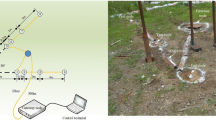Abstract
Using the improved Hilbert–Huang transform (HHT), this paper investigates the problems of analysis and interpretation of the energy spectrum of a blast wave. It has been previously established that the energy spectrum is an effective feature by which to characterize a blast wave. In fact, the higher the energy spectra in a frequency band of a blast wave, the greater the damage to a target in the same frequency band. However, most current research focuses on analyzing wave signals in the time domain or frequency domain rather than considering the energy spectrum. We propose here an improved HHT method combined with a wavelet packet to extract the energy spectrum feature of a blast wave. When applying the HHT, the signal is first roughly decomposed into a series of intrinsic mode functions (IMFs) by empirical mode decomposition. The wavelet packet method is then performed on each IMF to eliminate noise on the energy spectrum. Second, a coefficient is introduced to remove unrelated IMFs. The energy of each instantaneous frequency can be derived through the Hilbert transform. The energy spectrum can then be obtained by adding up all the components after the wavelet packet filters and screens them through a coefficient to obtain the effective IMFs. The effectiveness of the proposed method is demonstrated by 12 groups of experimental data, and an energy attenuation model is established based on the experimental data. The improved HHT is a precise method for blast wave signal analysis. For other shock wave signals from blasting experiments, an energy frequency time distribution and energy spectrum can also be obtained through this method, allowing for more practical applications.







Similar content being viewed by others
References
Girin, A.: Attenuation of a point blast shock wave in the dusty air. J. Loss Prev. Process Ind. 26(6), 1569–1573 (2013)
He, N., Liu, Y.D., Zhang, H.P., Li, C.P.: Research on the TNT equivalence of aluminized explosive. Proc. Eng. 43, 449–452 (2012)
Sochet, I., Gardebas, D., Calderara, S., Marchal, Y., Longuet, B.: Blast wave parameters for spherical explosives detonation in free air. Open J. Saf. Sci. Technol. 1(02), 31–42 (2011)
Omang, M., Christensen, S.O., Borve, S.: Height of burst explosions: a comparative study of numerical and experimental results. Shock Waves 19(2), 135–143 (2009)
De Armas, W., Mamun, K.A., Chau, T.: Vocal frequency estimation and voicing state prediction with surface EMG pattern recognition. Speech Commun. 63, 15–26 (2014)
Iatsenko, D., McClintock, P.V.E., Stefanovska, A.: Extraction of instantaneous frequencies from ridges in time-frequency representations of signals. Signal Process 125, 290–303 (2016)
Pai, P.F.: Time-frequency analysis for parametric and non-parametric identification of nonlinear dynamical systems. Mech. Syst. Signal Process. 36(2), 332–353 (2013)
Huang, N.E., Zheng, S., Long, S.R., Wu, M.C., Shih, H.S., Zheng, Q., Yen, N.C., Tung, C.C., Liu, H.H.: The empirical mode decomposition and the Hilbert spectrum for nonlinear and non-stationary time series analysis. Proc. R. Soc. Lond. A Math. Phys. Eng. Sci. Proc. R. Soc. 454, 903–995 (1998)
Shen, W.C., Chen, Y.H., Wu, A.Y.A.: Low-complexity sinusoidal-assisted EMD (SAEMD) algorithms for solving mode-mixing problems in HHT. Dig. Signal Process. 24, 170–186 (2014)
Peng, Z.K., Tse, P.W., Chu, F.L.: An improved Hilbert-Huang transform and its application in vibration signal analysis. J. Sound Vib. 286(1), 187–205 (2005)
Wu, Z., Huang, N.E.: Ensemble empirical mode decomposition: A noise-assisted data analysis method. Adv. Adapt. Data Anal. 1(01), 1–41 (2009)
Peng, J., Zhang, G.: Analysis of signal characteristics of swirlmeter in oscillatory flow based on Hilbert–Huang Transform (HHT). Measurement 45(7), 1765–1781 (2012)
Sun, H.M., Jia, R.S., Du, Q.Q., Fu, Y.: Cross-correlation analysis and time delay estimation of a homologous micro-seismic signal based on the Hilbert–Huang transform. Comput. Geosci. 91, 98–104 (2016)
Peng, Z.K., Tse, P.W., Chu, F.L.: A comparison study of improved Hilbert-Huang transform and wavelet transform: Application to fault diagnosis for rolling bearing. Mech. Syst. Signal Process. 19(5), 974–988 (2005)
Yin, Y., Hu, X., Xiong, H.U.: HHT time-frequency energy spectrum technique used in main joints condition monitoring of QCC track. Proc. Eng. 37, 197–201 (2012)
Kong, L., Su, J.J., Li, Z.R., Ji, J.R., Yin, J.L.: Energy spectrum analysis of several kinds of explosive blast. Chin. J. Explos. Propel. 33(6), 76–79 (2010) (in Chinese)
Acknowledgments
The work described in this paper is supported by the National Natural Science Foundation of China (NSFC: 11372143).
Author information
Authors and Affiliations
Corresponding author
Additional information
Communicated by C. Needham and A. Higgins.
Rights and permissions
About this article
Cite this article
Li, L., Wang, F., Shang, F. et al. Energy spectrum analysis of blast waves based on an improved Hilbert–Huang transform. Shock Waves 27, 487–494 (2017). https://doi.org/10.1007/s00193-016-0667-7
Received:
Revised:
Accepted:
Published:
Issue Date:
DOI: https://doi.org/10.1007/s00193-016-0667-7



